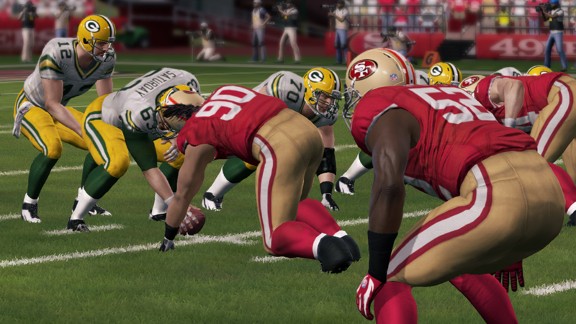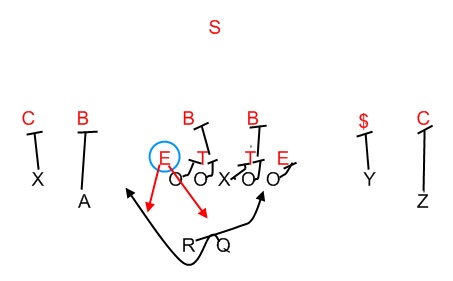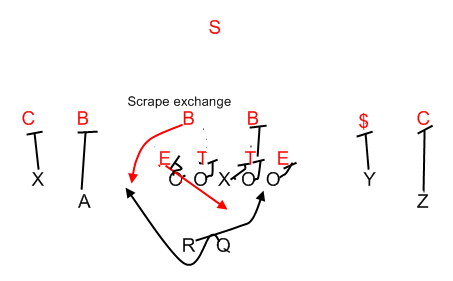
BURNING QUESTION #1
How to defend against the read option offensive approach.
Before I delve into anything regarding the Packers offense, and all of the intriguing issues and changes that we are certainly on the precipice of; I feel I have no choice but to sustain my immediate desire to help them, or moreover help myself, understand the issues apparent on defense.
In this segment I am going to be critical of the lackluster performance by our defense in the divisional playoff round against the San Francisco 49ers. It wasn't the first time we saw our D struggle against different versions of what we currently call the "Read Option" which I will abbreviate to "RO" to save space. It was indeed the most embarrassing and the most costly. All week writers and analysts spoke about the biggest difference in this 49ers team from week 1 to the playoffs was the change at quarterback from Smith to Kaepernic. The monumental difference it made against the Packers in the the playoff game at "The Stick" I don't believe anyone could have predicted. Its almost laughable now looking back at some of the pro Packer articles written insisting that "this wasn't the same Packer team that walked on the field week one;" and I don't believe they were insinuating they were any worse. In fact many were thinking they were better. By the end of the game the truth was revealed and the proof was stinking up the pudding.
I am a firm believer that football teams are generally created equal. If an athlete is signed to an NFL team that means he is an amazing, one in a million talent. There are no slouches playing in the league right now. It is the reason parody exists in the league. As one team falls another begins its ascent into football domination. This is one of the most unique and compelling facets of the game. It is also the reason you do not see a lot of teams getting blown out week after week.
Another thing that makes this game so special is that no matter how long its played it is constantly evolving. Two years ago and really last year especially the "Spread Passing Attack" was something teams were having fits over. Teams that had stud quarterbacks were using multiple wide receiver/tight end sets. Even taking there running back completely out of the backfield. The idea was to send more receivers out than a defense had adequate backs to cover. Aaron Rodgers was a quarterback made for that type of offense. His mobility and allusiveness in the pocket left little need for extra protection. His acute awareness of the blitz made him lethal with the ball in his hands. In 2011 he used this type of Arial Assault to rewrite history with 45 touchdown passes and and astonishing 6 interceptions. Other teams offenses were doing everything they could to mimic this approach while defenses tripped over each other trying to find a way to stop it.
Unfortunately, as newtons law goes, what goes up must come down. And so it did with a kersplat. Teams figured out the Achilles Heal of that particular offensive approach. The strangest thing about it is how simple the answer was. Whats perhaps more disturbing is how long it took teams to figure it out. If you haven't heard how you stop it I can explain it in one sentence. DROP YOUR SAFETIES BACK. Its a lot harder for a quarterback to burn you deep if you have an extra guy in coverage back there.
Now if your wondering why I'm bringing this all up and thinking in your head, "Uh Chandler, I thought you weren't going to be talking about offense." I say to you, "Just chill, I getting to my point."
As easy as it was for teams to slow down the heavy/deep passing attack, I firmly believe its every bit as easy to stop the "RO." It may even be easier.... Whaaaaa? I know, sounds crazy but just hear me out. I've begun my research on defending this offensive style and it actually has me excited. Its sounds ludicrous to be excited about anything that brought our season to an end but here's why. First of all, the RO isn't a new thing. College teams have used it for years and thus college teams have developed effective techniques of stopping it. Second, the reason college teams run this style of offense is because most college teams don't have Aaron Rodgers behind center. The have to rely on a guy that they cannot trust to throw the ball effectively more than 20 times a game. And even that number is high. The RO gives your quarterback several options on every down. Judging by what the defense looks like on the opposite side of the field the offense is structured in such a way that the quarterback can throw it, hand it off, or even and tuck and run with it himself. Giving the quarterback options alleviates the pressure to throw the ball while simultaneously adding a dimension to his game that makes him more dangerous.
So now we know why its used and that "other teams" (meaning, obviously not ours) have in the past had success stopping this approach. No we just need to know how they did it so the Packers can implement this into there defensive playbooks and not look like jerks the next time somebody tries it on us. Don't think for a second we have seen the last of it because you are fooling yourself. Not only do we play the 9ers in San Francisco next season but I'm sure any other teams with a quarterback that isn't confined to a wheelchair may try to include this into their arsenal after seeing how effective SF was with it.

Much of what is new in defending the spread involves giving different looks on the backside of all those “zone-read” and other read plays that spread teams are so fond of. For example, on the typical zone-read play, the line is responsible for blocking everyone but the backside defensive end; the quarterback “reads” him. If he crashes to take the runningback (or at least to eliminate the runningback’s cutback lane), the quarterback keeps it; if the defensive end is not in position to tackle the runner (either because he stays put or takes the quarterback, the QB simply hands the ball off to the runner.

Defenses began reacting by using a technique called a “scrape exchange” to mess up the read. With this defensive adjustment, the defensive end always crashes for the running-back while the linebacker “scrapes” over to take the quarterback. If the quarterback doesn't see this, he will pull the ball, thinking he will have an easy lane on the backside, and instead runs straight into the linebacker.

If the offense knows that the defense is shifting to this (a big if), what is the adjustment? Tell the tackle to block the defensive end, and the quarterback to read the linebacker. Often the linebacker will take himself out of the play, and with good blocking, the offense should be able to get a good run play, or a big play if the runner can cut back.
But let’s step back from scheme: what else can a defense do? One answer, is just to get more athletic. As TCU’s excellent coach Garry Patterson recently told the NY Times’s Pete Thamel:
Patterson’s base defense consists of four down linemen, two linebackers and five defensive backs. Many teams have gone away from four-man defensive lines and have added a linebacker for a 3-4 alignment, but Patterson chooses to keep the front stout and the back end of the defense flexible.It is a simple concept for a complicated challenge.“ You've got to spread out with them,” he said. “We try to coach defense like coaches coach offense.”Patterson’s theories on slowing down the spread quickly come back to speed.“If the defensive end is fast enough to be able to play the running back or the quarterback instead of some other person on your defense, that frees up a guy,” he said. “If nine guys out of your 11 can run somebody down, it always helps.”
This last quote is the most important. Reconsider the diagrams above. Now, let’s say (a) that the defensive end (or linebacker in a “scrape-exchange” scheme) is a real stud, and (b) that the quarterback is nothing special — not a Pat White or Vince Young. In that case, when the defense sees the zone read the defender being “read” can pretty much just wait until he knows whether the QB or RB is keeping it, and then attack accordingly. Unless the quarterback is a real athletic threat (think of Michigan’s motley quarterbacking crew from last season), that defender can play both the zone-read and not fear having the quarterback run by him; if the QB runs, he’ll get ‘em.
The obvious answer for the offense is to get more athletic at quarterback (like Michigan is trying to do), but there are other things, like amping up the options on the backside reads for the QB if he doesn’t give it to the back. But, as always, the chess match goes on and on . . . .
Thanks to Chris of smartfootball.com for the insight in how to defend this thing. I wish Dom Capers and the defense good luck with this. I really do think we have the right personal to be successful in stopping it. Like everything else, it just takes practice.
CATCH YOU ON THE FLIP!

No comments:
Post a Comment